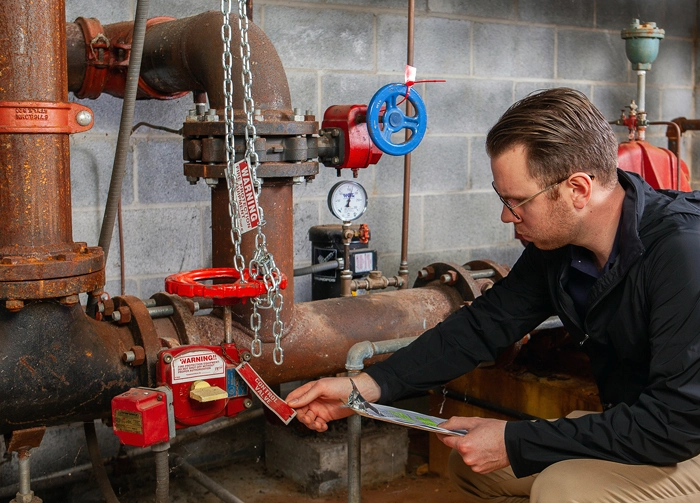
Gold Standard in Structure Protection
Civilian death rates from fire are 87% lower in properties with sprinklers that operate than in
properties
with non-working or no sprinklers, per NFPA. And the Safe Drinking Water Act protects our potable water
supplies from contaminated fire sprinkler backflow—when installed and maintained properly.
Why Choose Commercial Fire for your Fire Sprinkler/Backflow Service
Our experienced technicians offer best in-class service when it comes to maintaining your Fire Sprinkler
and
Backflow systems. Our team will ensure all systems are up to code and fully operational in the event of an
emergency.

Maintenance Schedule
Every Week or Every Month
- Depending on the system, inspection of gauges (wet, deluge, and dry systems)
Every Month
- Inspect gauges for wet, deluge, and dry systems
Every 3 Months
- Physically test fire sprinkler mechanical devices
- Inspect water flow valve alarm devices, signal devices, hydraulic nameplates, electrically
supervised control valves,
and FDCs
Every Year
- Required inspection of your building's fittings/sprinklers, hangers and seismic bracing
- Required testing and inspection of control valves, gauges, backflow preventer, anti-freeze
loops,
alarm switches, visible piping, and fire department connections
- Inspection and trip test of dry, pre-action, and deluge systems
- Physically test the entire fire sprinkler system
Every 5 Years
- Inspection of hoses, containers, and piping service as needed
- Standpipe testing (including dry standpipe hydrostatic testing)
- Internal pipe inspections and obstruction investigations
- Inspect all sprinkler piping for any blockage
- Test sprinklers exposed to high temps or harsh conditions
Every 20 Years
- Physically test fast-response sprinklers and dry sprinkler heads at 20 years, then every 10
years
thereafter
Every 50 Years
- Physically test standard sprinklers at 50 years, then every 10 years thereafter
NFPA, NFPA25 retrieved from https://www.nfpa.org/codes-and-standards/2/5/25
(Table 5.1.1.2 - 2023 Edition) on January
2, 2024.
The CF Inspection Checklist
Inspect
- Fire department connection (FDC)
- Riser, bracing, and control valves
- Gauges
- Water flow switch and alarm bell
- Control valves
- Inspect sprinkler heads (confirm required sprinkler heads and wrench are present)
- Main drain (static and residual psi)
- Check valves, cross mains, and remote branch lines (every 5 years)
- Pre-action and deluge systems, gauges, and control valve
- Spare sprinklers
- Pipes and fittings
- Signage
Test
- Water flow switch and alarm bell
- Control valves
- Main drain (static and residual psi)
- Fire pump
- Alarm devices
- Deluge
- Antifreeze solution
- Pre-action valve
Verify
- Ensure 3-way test valve is present and open
The Two Types of Backflow
Backpressure
- Caused by an increase in pressure in the downstream piping, reversing the normal flow direction
Backsiphonage
- Reversal of the normal flow in the piping, resulting in negative pressure in the supply piping
Note: Backflow device(s) are tested on an annual basis, unless the water purveyors require the RP or RPZ
to
be tested semi-annually. Inspection of backflow devices is not required as part of the sprinkler
inspection.
Commercial Fire is also available 24/7, should you need additional service. From replacing and repairing
to
installing new equipment, we're your total fire sprinkler system service solution.